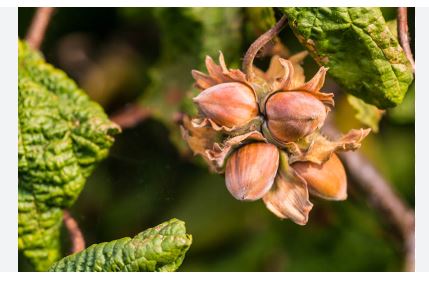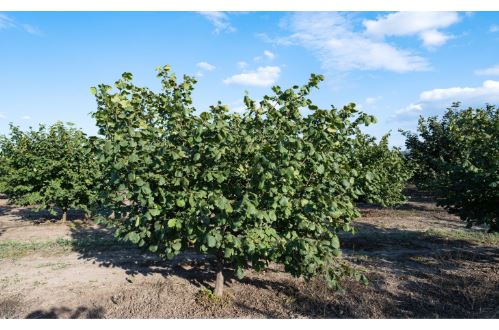
Hazelnut trees, prized for their flavorful, nutrient-rich nuts, are deciduous shrubs or small trees that add charm and productivity to temperate gardens. Native to Europe, Asia, and North America, these trees produce round or oval nuts encased in leafy husks, cherished in confections, spreads, and savory dishes. Their catkins, which bloom in late winter to early spring, lend ornamental appeal, while their heart-shaped leaves turn vibrant hues in fall. Hazelnuts are a staple in culinary traditions, from European desserts to global snacks, and their oil is used in cosmetics.
Growing 10–20 feet tall, hazelnut trees thrive in USDA zones 4–8, preferring well-drained, loamy soil and moderate climates with cool winters for nut development. They are monoecious, bearing both male and female flowers, but cross-pollination between trees boosts yields. Full sun to partial shade suits them, and they adapt to various soil types, though a pH of 6–7 is ideal. Their compact size makes them suitable for home gardens, orchards, or hedgerows, often planted in pairs for better nut production.
Cultivating hazelnut trees requires patience, as nuts appear 3–5 years after planting, with peak yields at 7–10 years. Regular pruning maintains shape and encourages fruiting, while mulching conserves moisture and suppresses weeds. Harvest nuts in late summer to fall when husks turn brown, drying them for storage. Squirrels and birds may compete for nuts, so netting or timely harvesting is essential. The trees’ deep roots stabilize soil, making them valuable for erosion control.
Hazelnut trees support biodiversity by providing habitat for wildlife and attracting pollinators like bees. Their nuts are packed with protein, healthy fats, and vitamins, offering nutritional benefits, while their shells can be used as mulch or biofuel. However, some people have nut allergies, so caution is needed in shared spaces. The trees are relatively low-maintenance, resisting many pests, though filbert blight and weevils require monitoring and organic controls.
To grow hazelnut trees, plant in early spring or fall, spacing 10–15 feet apart to ensure pollination. Water consistently during establishment, and apply a balanced fertilizer annually. Intercrop with nitrogen-fixing plants like clover to enhance soil health. Whether in a backyard or small orchard, hazelnut trees offer a rewarding blend of beauty, sustainability, and delicious harvests, enriching gardens with their versatile bounty.
Why Hazelnut Trees Are a Garden Gem
Hazelnut trees are prized for their compact size, typically 10–20 feet tall, making them ideal for small gardens, hedgerows, or orchards. Their heart-shaped, serrated leaves turn vibrant yellow, orange, or red in fall, while golden catkins add early spring charm. Monoecious, with separate male and female flowers on the same tree, they often require cross-pollination for optimal nut production, especially European varieties. Thriving in USDA zones 4–8, they adapt to various soils but prefer well-drained, loamy conditions with a pH of 6–7.5. Hazelnuts are nutrient-dense, offering protein, vitamin E, and healthy fats, earning the FDA’s heart-healthy seal. From erosion control to carbon sequestration, these trees enhance environmental health, making them a sustainable choice.

Hazelnut Trees
1. European Hazelnut (Corylus avellana)
European Hazelnut, also called common hazel or filbert, is the cornerstone of commercial nut production, native to Europe and Western Asia. Growing 12–20 feet tall with a 15-foot spread, it forms a multi-stemmed shrub or small tree with rounded, serrated leaves and yellow catkins. Its large, flavorful nuts, encased in short, leafy husks, are ideal for pralines, chocolate spreads, and baking. Thriving in zones 4–8, it prefers full sun and well-drained soil but is susceptible to Eastern Filbert Blight (EFB). Plant with pollinizers like Jefferson or Yamhill for better yields. European Hazelnut is perfect for gardeners seeking high-quality nuts in Mediterranean-like climates, such as Oregon’s Willamette Valley.
2. American Hazelnut (Corylus americana)
American Hazelnut, native to eastern North America, is a cold-hardy, blight-resistant shrub growing 8–12 feet tall with a spreading, thicket-forming habit. Its small, sweet nuts, encased in papery husks, are edible but smaller than European varieties, ripening in late summer. Thriving in zones 4–9, it tolerates shade and adapts to sandy or clay soils, making it ideal for wildlife plantings or naturalized areas. Its vibrant fall foliage—yellow, orange, and red—adds ornamental value. Pair with another American hazelnut for pollination. American Hazelnut is a top choice for Midwest gardeners seeking a low-maintenance, native nut producer.
3. Beaked Hazelnut (Corylus cornuta)
Beaked Hazelnut, found in northern U.S. and Canada, is a shade-tolerant shrub or small tree (8–10 feet) with distinctive, elongated, beaked husks covering its small, tasty nuts. Hardy in zones 3–8, it thrives in forest understories or open sites with moist, well-drained soil. Its brilliant yellow and red fall foliage and resistance to EFB make it a resilient choice. Nuts ripen in August, attracting wildlife like squirrels and turkeys. Plant in groups for cross-pollination. Beaked Hazelnut suits gardeners in colder climates, like Minnesota, wanting a native, wildlife-friendly hazelnut tree.
4. Giant Hazelnut (Corylus maxima)
Giant Hazelnut, or giant filbert, native to southeastern Europe, grows 12–15 feet with thick stems and large, rounded nuts in fringed husks. Its dark green, ovate leaves turn yellow in fall, and its nuts are prized for pralines and pastes. Thriving in zones 5–8, it prefers full sun and fertile, well-drained soil but is EFB-susceptible. Pollinizers like Barcelona enhance yields. Its vase-shaped canopy suits hedges or specimen planting. Giant Hazelnut is ideal for gardeners in mild climates seeking large, flavorful nuts for culinary use.
5. Turkish Hazelnut (Corylus colurna)
Turkish Hazelnut, a tree-form hazel reaching 40–50 feet, is grown for its edible Constantinople nuts and ornamental value. Native to Turkey and the Balkans, it features a pyramidal shape, corky bark, and serrated leaves with modest yellow fall color. Hardy in zones 4–7, it tolerates drought and poor soils but needs pollinizers for nut production. Its nuts, smaller than European varieties, are sold in-shell. Turkish Hazelnut is perfect for gardeners wanting a stately, low-maintenance tree for urban landscapes or orchards.
6. Barcelona (European Hazelnut Cultivar)
Barcelona, a widely grown European hazelnut cultivar, is a vigorous shrub (15–18 feet) with mid-sized, round-flat nuts in enveloping husks. Harvested in late September, its nuts have a 39.43% kernel-to-nut ratio and a tasty flavor, ideal for fresh markets. Hardy in zones 4–8, it resists bud mites but needs pollinizers like Halle’s Giant. Its upright habit suits commercial orchards. Barcelona is a go-to for growers in Oregon or similar climates seeking reliable yields and quality nuts.
7. Jefferson (European Hazelnut Cultivar)
Jefferson, an EFB-resistant European hazelnut cultivar from Oregon State University, grows 12–15 feet with high-yielding, medium-sized nuts. Blooming mid-season, it’s compatible with pollinizers like Yamhill or Wepster. Its nuts, ripening in September, are ideal for kernels or in-shell markets. Thriving in zones 5–8, it prefers well-drained soil and full sun. Jefferson is perfect for Pacific Northwest gardeners wanting a blight-resistant, productive hazelnut for commercial or home use.
8. Yamhill (European Hazelnut Cultivar)
Yamhill, another EFB-resistant Oregon cultivar, is a compact shrub (10–12 feet) with small, high-quality nuts suited for kernel markets. Its early-season bloom and harvest (August–September) make it efficient for growers. Hardy in zones 5–8, it thrives in full sun and needs pollinizers like Jefferson. Its dense foliage and modest size fit small gardens or orchards. Yamhill is ideal for gardeners seeking a low-maintenance, blight-resistant hazelnut with commercial potential.
9. Wepster (European Hazelnut Cultivar)
Wepster, an Oregon-bred, EFB-resistant cultivar, grows 10–15 feet with small, flavorful nuts perfect for kernel production. Its vigorous, upright habit and mid-season bloom pair well with pollinizers like Yamhill. Hardy in zones 5–8, it prefers fertile, well-drained soil and full sun. Harvested in early fall, its nuts suit chocolate and baking industries. Wepster is a top pick for growers in temperate regions wanting a compact, high-yielding hazelnut tree.
10. American Hybrid Hazelnut (C. americana x C. avellana)
American Hybrid Hazelnut, a cross between American and European hazelnuts, combines EFB resistance and cold hardiness with larger, tastier nuts. Growing 10–15 feet, these shrubs thrive in zones 4–9, tolerating diverse soils and partial shade. Developed by the Hybrid Hazelnut Consortium, they yield nuts in 3–5 years, ripening in September. Pollinate with other hybrids or American hazelnuts. American Hybrid Hazelnut is ideal for Midwest or Northeast gardeners seeking sustainable, productive trees for marginal lands.
11. Tonda di Giffoni (European Hazelnut Cultivar)
Tonda di Giffoni, an Italian cultivar, is a compact shrub (10–12 feet) with round, high-quality nuts prized for pastes and confections. Hardy in zones 5–8, it blooms early and needs pollinizers like Barcelona. Its nuts, harvested in September, have excellent flavor and a high kernel ratio. Thriving in full sun and well-drained soil, it resists some pests. Tonda di Giffoni suits gardeners in Mediterranean climates wanting premium nuts for gourmet markets.
12. Purple-Leaf Filbert (Corylus maxima ‘Purpurea’)
Purple-Leaf Filbert, an ornamental cultivar, grows 12–15 feet with striking, deep purple foliage and red-tinted catkins. Its edible nuts, though smaller, are encased in fringed husks. Hardy in zones 4–8, it prefers full sun for vibrant color and well-drained soil. EFB-susceptible, it’s best for decorative use in borders or shrubberies. Purple-Leaf Filbert is perfect for gardeners seeking a dual-purpose hazelnut with bold aesthetics and modest nut production.
13. Asian Hazelnut (Corylus heterophylla)
Asian Hazelnut, native to East Asia, is a cold-hardy shrub (10–15 feet) with small, edible nuts in short husks. Thriving in zones 4–8, it tolerates poor soils and partial shade, producing nuts in 2–3 years. Its ovate, serrated leaves turn yellow in fall, and its upright habit suits hedges. Pollinate with another Asian or hybrid hazelnut. Asian Hazelnut is ideal for gardeners in colder Asian or North American regions wanting a resilient, early-yielding tree.
14. Grand Traverse (Hybrid Hazelnut Cultivar)
Grand Traverse, a Michigan hybrid of Turkish and European hazelnuts, grows 12–15 feet with medium-sized, flavorful nuts. Hardy in zones 4–8, it’s EFB-resistant and blooms mid-season, pairing with pollinizers like NY 398. Its nuts, harvested in September, suit in-shell markets. Thriving in full sun and loamy soil, it’s low-maintenance. Grand Traverse is a great choice for northern growers seeking a hardy, productive hybrid for home or small-scale orchards.
15. Contorted Hazelnut (Corylus avellana ‘Contorta’)
Contorted Hazelnut, or Harry Lauder’s Walking Stick, is an ornamental European cultivar growing 8–10 feet with twisted, curling branches. Its small, edible nuts are secondary to its striking winter silhouette and yellow catkins. Hardy in zones 4–8, it’s EFB-susceptible and prefers full sun and well-drained soil. Use as a focal point or in mixed borders. Contorted Hazelnut.
Design Ideas for Hazelnut Tree Gardens
Hazelnut trees offer versatile landscaping options. Create a nut-producing hedge with American Hazelnut and Beaked Hazelnut for wildlife-friendly borders. Plant Purple-Leaf Filbert in a mixed shrubbery with evergreens for year-round color contrast. Use Contorted Hazelnut as a winter focal point near a patio, paired with spring bulbs like tulips. Establish a small orchard with Jefferson and Yamhill for commercial yields, intercropped with clover for soil health. Grow Turkish Hazelnut as a shade tree in urban yards, underplanted with shade-tolerant perennials. These designs blend aesthetics, productivity, and ecological benefits, enhancing any garden.
Growing Hazelnut Trees: Essential Tips
To cultivate hazelnut trees, plant in spring or fall in well-drained, loamy soil with a pH of 6–7.5, spacing 15–20 feet apart for cross-pollination. Dig a hole twice the root ball’s width, amend with organic compost, and water deeply during establishment. Ensure full sun (4+ hours daily) for optimal nut production, though American varieties tolerate partial shade. Prune suckers annually to maintain a shrub or single-stem tree form, and apply a balanced fertilizer (10-10-10) in spring. Harvest nuts in late summer to fall when husks brown, using tarps or mechanical sweepers for efficiency. Protect from squirrels with netting and monitor for EFB, filbertworm, or aphids, using integrated pest management (IPM). Mulch to retain moisture and prevent weeds, avoiding trunk contact to prevent rot.